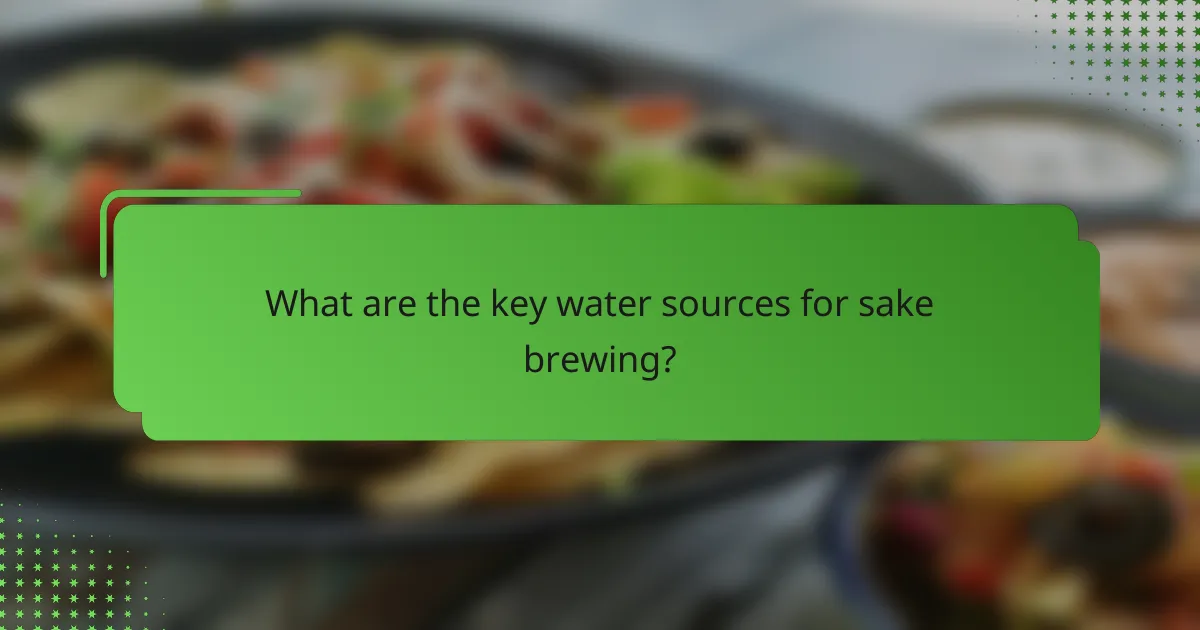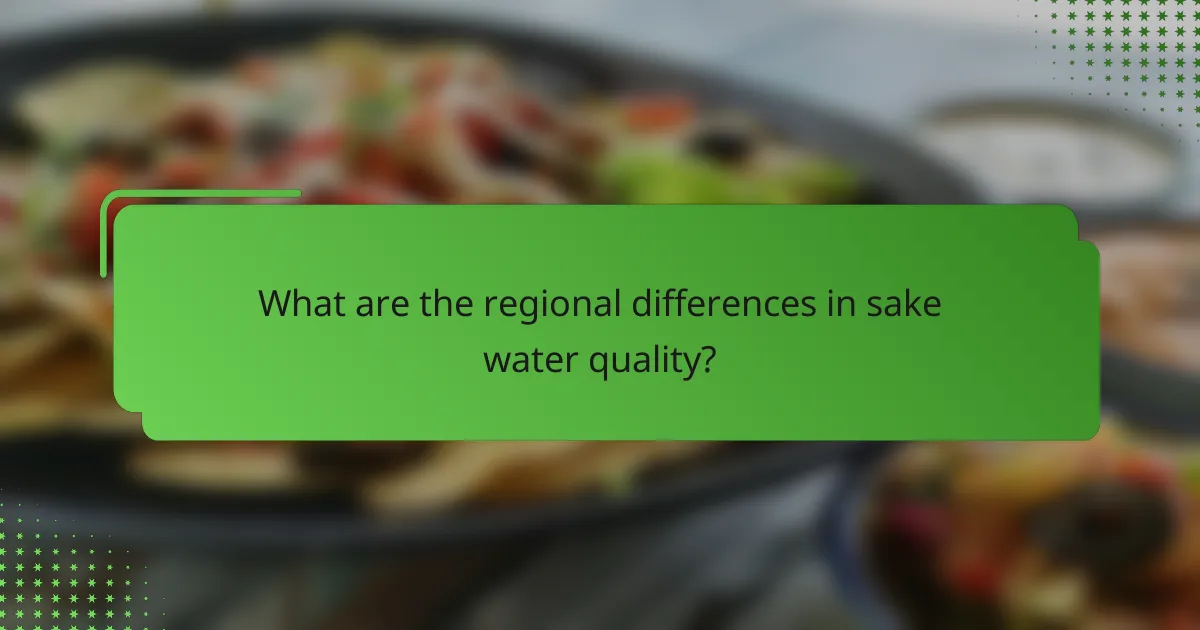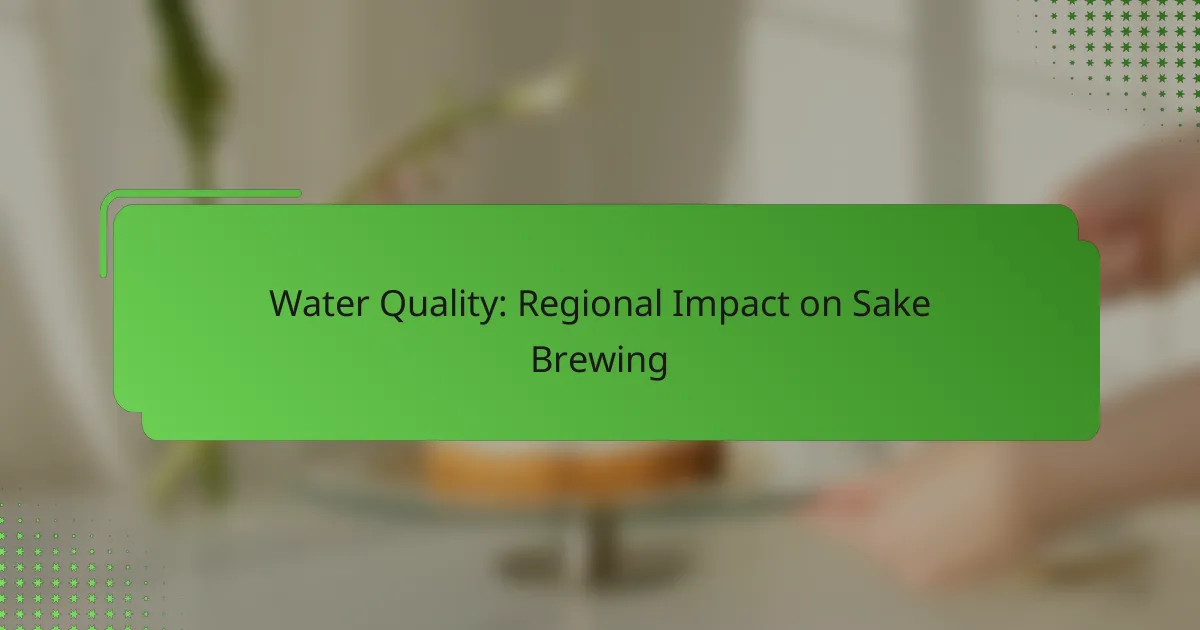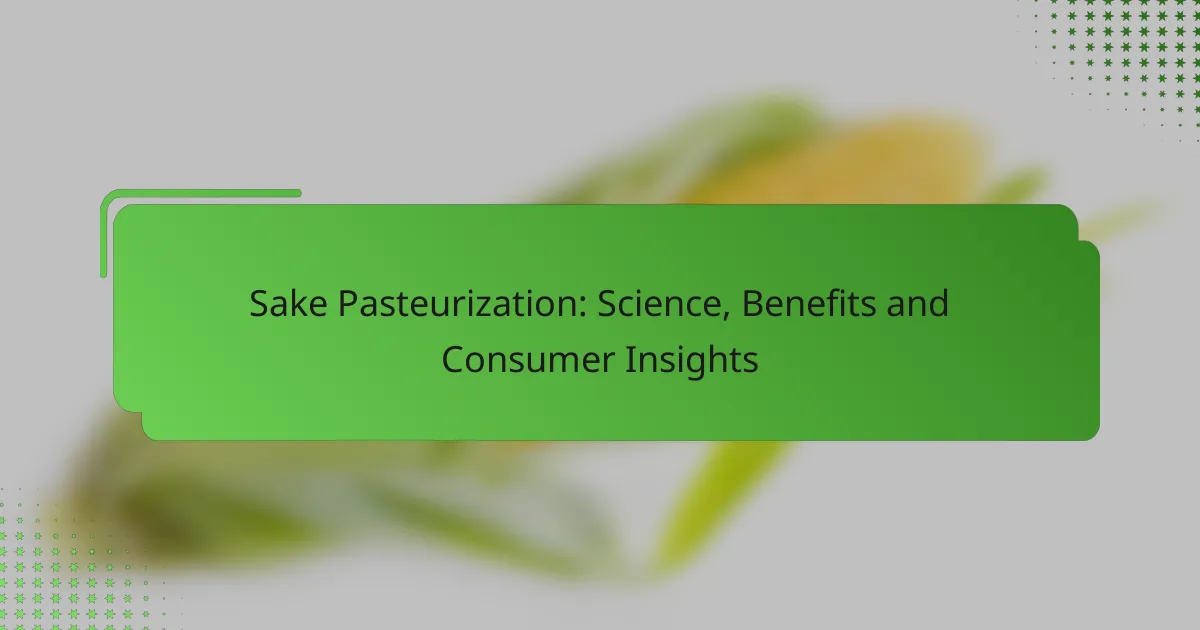Water quality plays a pivotal role in sake brewing, directly influencing the flavor, fermentation, and overall quality of the beverage. The mineral content, pH levels, and hardness of the water are critical factors that brewers must consider to achieve the desired taste and characteristics. Regions renowned for sake production often possess unique water profiles that enhance the brewing process, making water quality a fundamental aspect of this traditional craft.

How does water quality affect sake brewing in Japan?
Water quality is crucial in sake brewing, as it directly impacts the flavor, fermentation process, and overall quality of the final product. Factors such as mineral content, pH levels, and water hardness must be carefully considered to achieve the desired characteristics in sake.
Mineral content influences flavor
The mineral content of water plays a significant role in determining the flavor profile of sake. Essential minerals like magnesium, calcium, and potassium contribute to the umami and sweetness of the drink. For instance, water with higher magnesium levels can enhance the richness of the sake, while calcium can improve the overall mouthfeel.
Brewers often select water sources based on their mineral composition to create specific flavor profiles. For example, the soft waters of the Fushimi region are known for producing light and delicate sake, while the harder waters found in the Niigata region can yield richer and fuller-bodied varieties.
pH levels impact fermentation
pH levels in brewing water affect the fermentation process and the activity of yeast. Ideal pH levels for sake brewing typically range from 5.0 to 6.0, which supports healthy yeast growth and fermentation efficiency. If the pH is too high or too low, it can lead to sluggish fermentation or off-flavors in the final product.
Brewers may adjust the pH of their water using various methods, such as adding acids or bases, to ensure optimal conditions for fermentation. Monitoring pH levels throughout the brewing process is essential for maintaining consistency and quality in sake production.
Water hardness affects brewing techniques
Water hardness, determined by the concentration of calcium and magnesium ions, influences brewing techniques and the overall brewing environment. Soft water is generally preferred for brewing premium sake, as it allows for better control over fermentation and flavor extraction. Conversely, hard water can complicate the brewing process and may require adjustments in techniques.
Brewers in regions with hard water often use techniques such as dilution with soft water or specific filtration methods to achieve the desired hardness. Understanding the hardness of the water source helps brewers tailor their methods to produce high-quality sake that meets consumer expectations.

What are the key water sources for sake brewing?
The primary water sources for sake brewing significantly influence the final product’s flavor and quality. Regions known for sake production often have specific water characteristics that enhance the brewing process, making them essential to the craft.
Yamada Nishiki rice region
The Yamada Nishiki rice region, primarily located in Hyogo Prefecture, is renowned for producing high-quality sake rice. The region’s fertile soil and favorable climate contribute to the rice’s unique properties, which are crucial for brewing premium sake.
Water quality in this area is also vital, as it affects the fermentation process. Soft water is preferred, as it allows for a smoother fermentation, enhancing the delicate flavors of the Yamada Nishiki rice.
Fushimi water source
Fushimi, located in Kyoto, is famous for its soft water, which is ideal for sake brewing. The water here is drawn from underground springs, providing a mineral balance that promotes a clean and crisp taste in the final product.
Breweries in Fushimi often emphasize the purity of their water, which is a key selling point. The soft water helps to highlight the subtle flavors of the sake, making it a popular choice among brewers and consumers alike.
Niigata water characteristics
Niigata Prefecture is known for its unique water characteristics, which are typically soft and rich in minerals. This type of water is beneficial for brewing sake, as it supports the development of complex flavors while maintaining a smooth mouthfeel.
The region’s water is sourced from snowmelt, which contributes to its purity and quality. Many breweries in Niigata take pride in their water source, often highlighting it in their marketing to attract consumers seeking high-quality sake.

How can brewers optimize water quality for sake?
Brewers can optimize water quality for sake by employing effective treatment methods, blending techniques, and consistent testing. Each step is crucial to ensure the water enhances the sake’s flavor profile and meets quality standards.
Water treatment methods
Water treatment methods for sake brewing include filtration, softening, and mineral adjustment. Filtration removes impurities, while softening reduces hardness, which can affect the brewing process. Adjusting minerals like calcium and magnesium can enhance fermentation and flavor.
Common methods include reverse osmosis for filtration and ion exchange for softening. Brewers should aim for water with a balanced mineral composition, often targeting a hardness level of around 30-50 mg/L for optimal results.
Blending techniques
Blending techniques involve mixing different water sources to achieve the desired quality for sake production. Brewers often blend soft water with harder water to create a balanced profile that supports yeast activity and flavor development.
For example, using local spring water known for its purity can be combined with mineral-rich water to enhance taste complexity. A common practice is to maintain a ratio of 70% soft water to 30% hard water, but adjustments should be made based on specific brewing goals.
Testing and monitoring
Regular testing and monitoring of water quality are essential for successful sake brewing. Brewers should test for pH, hardness, and mineral content to ensure consistency and quality in their products. This process helps identify any changes that may affect the brewing process.
Using simple testing kits or sending samples to labs can provide insights into water quality. Monitoring should be done before each brewing cycle, and adjustments should be made based on the results to maintain optimal brewing conditions.

What are the regional differences in sake water quality?
Regional differences in sake water quality significantly influence the brewing process and the final flavor profile of the sake. Factors such as mineral content, pH levels, and water hardness vary by location, affecting the fermentation and overall quality of the sake produced.
Kyoto vs. Niigata water profiles
Kyoto’s water is known for its soft quality, with low mineral content that allows for delicate flavor profiles in sake. This softness enhances the umami and sweetness, making it ideal for brewing refined, aromatic sakes.
In contrast, Niigata’s water is characterized by a higher mineral content, particularly calcium and magnesium, which contributes to a more robust flavor. This mineral-rich water supports the production of sakes with a fuller body and a crisp finish, often preferred in the region.
Impact of local geology
The local geology plays a crucial role in determining the mineral composition of water used in sake brewing. In areas with limestone or granite, such as Niigata, the water tends to be harder and more mineral-rich, which can enhance fermentation efficiency.
Conversely, regions with softer sedimentary rocks, like those found in Kyoto, produce water that is low in minerals. This geological difference not only affects the taste but also influences the brewing techniques, as brewers must adapt their methods to the water’s characteristics to achieve the desired sake quality.

What are the trends in water quality research for sake?
Recent trends in water quality research for sake focus on understanding the chemical composition of water and its influence on brewing processes. Researchers are exploring how different filtration methods and environmental changes affect the purity and mineral content of water used in sake production.
Emerging filtration technologies
Emerging filtration technologies are revolutionizing how sake brewers purify their water. Techniques such as reverse osmosis and advanced carbon filtration are becoming more common, allowing brewers to remove impurities while retaining essential minerals. These methods can enhance the flavor profile of sake, making it smoother and more refined.
Brewers should consider the trade-offs of these technologies, as some filtration methods may strip away beneficial minerals that contribute to the sake’s character. A balanced approach is essential; for instance, using a multi-stage filtration system can help maintain the desired mineral content while ensuring water purity.
Impact of climate change on water sources
Climate change is significantly impacting water sources crucial for sake brewing. Altered precipitation patterns and rising temperatures can lead to changes in water availability and quality, affecting the consistency of sake production. Regions traditionally known for their pure water may face challenges as water sources become less reliable.
Brewers need to adapt to these changes by monitoring water quality regularly and considering alternative sources if necessary. Implementing sustainable practices, such as rainwater harvesting or using recycled water, can help mitigate the effects of climate change on sake brewing. Staying informed about local water regulations and environmental conditions will also be crucial for maintaining high-quality sake.

How is water quality evolving in the sake industry?
Water quality in the sake industry is increasingly recognized as a critical factor influencing flavor profiles and brewing efficiency. As brewers adapt to changing environmental conditions and consumer preferences, they are implementing innovative practices to ensure the purity and sustainability of their water sources.
Innovations in sustainable sourcing
Sake brewers are increasingly turning to sustainable water sourcing methods to maintain high-quality production. This includes utilizing rainwater harvesting systems and groundwater filtration techniques that minimize environmental impact while ensuring water purity. For instance, some breweries are investing in advanced filtration systems that can remove impurities without the use of chemicals.
Additionally, partnerships with local water authorities are becoming common, allowing brewers to access water quality data and engage in conservation efforts. These collaborations can lead to more efficient water use and improved overall quality, benefiting both the brewery and the surrounding ecosystem.
Future of regional water management
The future of regional water management in sake brewing will likely focus on balancing traditional practices with modern sustainability goals. As climate change alters precipitation patterns, brewers may need to adapt their sourcing strategies to ensure consistent water quality. This could involve diversifying water sources or investing in technology to monitor water quality in real-time.
Moreover, regulatory frameworks may evolve to support sustainable practices, encouraging brewers to adopt water-efficient technologies. By proactively engaging with local communities and environmental organizations, sake producers can play a pivotal role in shaping responsible water management policies that safeguard their resources for future generations.










